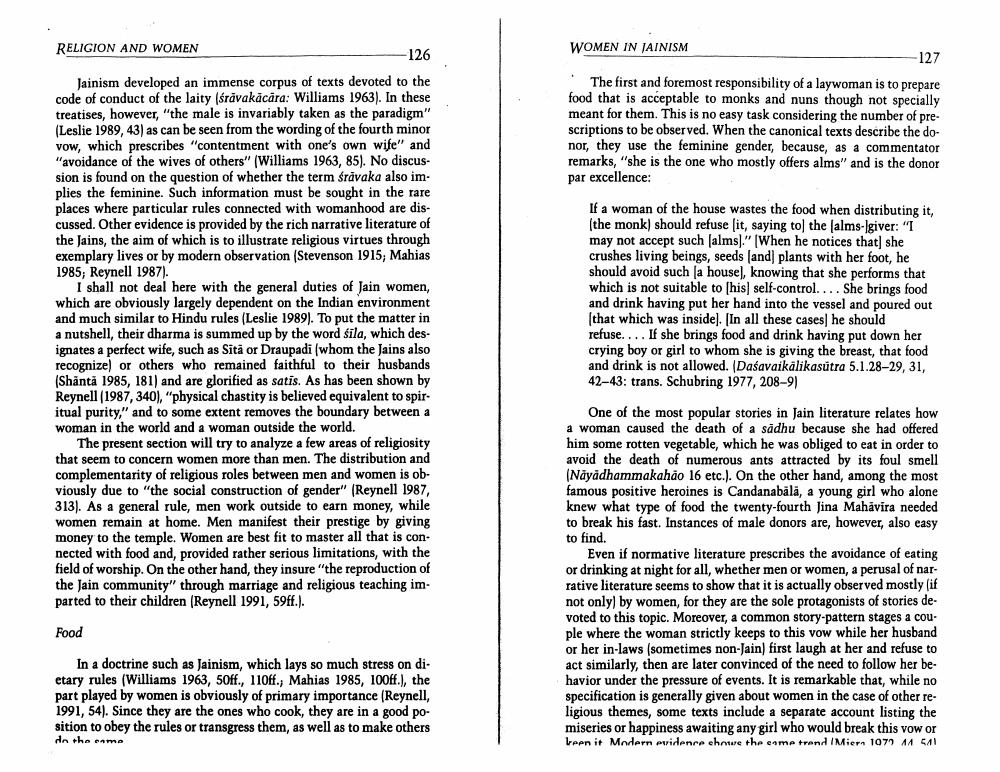Book Title: Women In Jainism Author(s): Nalini Balbir Publisher: Nalini Balbir View full book textPage 4
________________ WOMEN IN JAINISM 127 The first and foremost responsibility of a laywoman is to prepare food that is acceptable to monks and nuns though not specially meant for them. This is no easy task considering the number of prescriptions to be observed. When the canonical texts describe the donor, they use the feminine gender, because, as a commentator remarks, "she is the one who mostly offers alms" and is the donor par excellence: RELIGION AND WOMEN - 126 Jainism developed an immense corpus of texts devoted to the code of conduct of the laity śrāvakācāra: Williams 1963). In these treatises, however, "the male is invariably taken as the paradigm" (Leslie 1989, 43) as can be seen from the wording of the fourth minor vow, which prescribes "contentment with one's own wife" and "avoidance of the wives of others" (Williams 1963, 85). No discussion is found on the question of whether the term śrävaka also im. plies the feminine. Such information must be sought in the rare places where particular rules connected with womanhood are discussed. Other evidence is provided by the rich narrative literature of the Jains, the aim of which is to illustrate religious virtues through exemplary lives or by modern observation (Stevenson 1915, Mahias 1985; Reynell 1987). I shall not deal here with the general duties of Jain women, which are obviously largely dependent on the Indian environment and much similar to Hindu rules (Leslie 1989). To put the matter in a nutshell, their dharma is summed up by the word sila, which designates a perfect wife, such as Sità or Draupadi (whom the Jains also recognize) or others who remained faithful to their husbands (Shinta 1985, 181) and are glorified as satis. As has been shown by Reynell (1987, 340), "physical chastity is believed equivalent to spiritual purity," and to some extent removes the boundary between a woman in the world and a woman outside the world. The present section will try to analyze a few areas of religiosity that seem to concern women more than men. The distribution and complementarity of religious roles between men and women is obviously due to "the social construction of gender" (Reynell 1987, 313). As a general rule, men work outside to earn money, while women remain at home. Men manifest their prestige by giving money to the temple. Women are best fit to master all that is connected with food and, provided rather serious limitations, with the field of worship. On the other hand, they insure "the reproduction of the Jain community through marriage and religious teaching im. parted to their children (Reynell 1991, 59ff.). If a woman of the house wastes the food when distributing it, (the monk) should refuse (it, saying to the salms-Igiver: "I may not accept such (alms)." (When he notices that she crushes living beings, seeds (and) plants with her foot, he should avoid such a house], knowing that she performs that which is not suitable to his self-control. ... She brings food and drink having put her hand into the vessel and poured out (that which was inside]. [In all these cases, he should refuse.... If she brings food and drink having put down her crying boy or girl to whom she is giving the breast, that food and drink is not allowed. (Daśavaikälikasutra 5.1.28–29, 31, 42-43: trans. Schubring 1977, 208-9) One of the most popular stories in Jain literature relates how a woman caused the death of a sadhu because she had offered him some rotten vegetable, which he was obliged to eat in order to avoid the death of numerous ants attracted by its foul smell (Nayadhammakahão 16 etc.). On the other hand, among the most famous positive heroines is Candanabala, a young girl who alone knew what type of food the twenty-fourth Jina Mahavira needed to break his fast. Instances of male donors are, however, also easy to find. Even if normative literature prescribes the avoidance of eating or drinking at night for all, whether men or women, a perusal of narrative literature seems to show that it is actually observed mostly if not only) by women, for they are the sole protagonists of stories de voted to this topic. Moreover, a common story-pattern stages a cou. ple where the woman strictly keeps to this vow while her husband or her in-laws (sometimes non-Jain) first laugh at her and refuse to act similarly, then are later convinced of the need to follow her behavior under the pressure of events. It is remarkable that, while no specification is generally given about women in the case of other religious themes, some texts include a separate account listing the miseries or happiness awaiting any girl who would break this vow or Leen it Modern evidence chmure the came trend I Miera 1079 11 541 Food In a doctrine such as Jainism, which lays so much stress on dietary rules (Williams 1963, 50ff., 110ff., Mahias 1985, 100ff.), the part played by women is obviously of primary importance (Reynell, 1991, 54). Since they are the ones who cook, they are in a good position to obey the rules or transgress them, as well as to make others do the camePage Navigation
1 2 3 4 5 6 7 8 9 10 11 12
